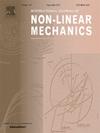Ring body problem dynamics under the albedo effect
IF 3.2
3区 工程技术
Q2 MECHANICS
International Journal of Non-Linear Mechanics
Pub Date : 2025-09-19
DOI:10.1016/j.ijnonlinmec.2025.105265
引用次数: 0
Abstract
This study explores the existence and characteristics of libration points, as well as their linear stability, in the ring-body problem while accounting for additional perturbations from radiation pressure and the albedo effect. Our analysis reveals that even minor variations in the number of peripheral primaries, can lead to significant changes in the system’s dynamics. The mass parameter plays a crucial role in determining the regions associated with libration points. To deepen our understanding, we compare the results of our proposed model with those of the classical ring-body problem. This comparison highlights substantial differences in the locations of the libration points and their respective linear stability. Notably, our findings indicate that the libration point , positioned at the center alongside the peripheral primary , remains unaffected by the considered perturbations. However, with a few exceptions, most identified libration points exhibit unstable behavior. We emphasize that the conducted study is crucial in astrophysics and orbital mechanics, as it helps model planetary ring systems (such as Saturn’s rings), protoplanetary disks, and even certain galactic formations.
反照率作用下的环体动力学问题
本研究在考虑辐射压力和反照率效应的额外扰动的情况下,探讨了环体问题中振动点的存在和特征,以及它们的线性稳定性。我们的分析表明,即使外围初级数量的微小变化,也会导致系统动力学的重大变化。质量参数β在确定与振动点相关的区域中起着至关重要的作用。为了加深我们的理解,我们将我们提出的模型的结果与经典的(N+1)环体问题的结果进行了比较。这种比较突出了振动点的位置及其各自的线性稳定性的实质性差异。值得注意的是,我们的研究结果表明,位于外围原发P0旁边的中心的振动点L0不受所考虑的扰动的影响。然而,除了少数例外,大多数确定的振动点表现出不稳定的行为。我们强调,所进行的研究在天体物理学和轨道力学中是至关重要的,因为它有助于模拟行星环系统(如土星环),原行星盘,甚至某些星系的形成。
本文章由计算机程序翻译,如有差异,请以英文原文为准。
求助全文
约1分钟内获得全文
求助全文
来源期刊
CiteScore
5.50
自引率
9.40%
发文量
192
审稿时长
67 days
期刊介绍:
The International Journal of Non-Linear Mechanics provides a specific medium for dissemination of high-quality research results in the various areas of theoretical, applied, and experimental mechanics of solids, fluids, structures, and systems where the phenomena are inherently non-linear.
The journal brings together original results in non-linear problems in elasticity, plasticity, dynamics, vibrations, wave-propagation, rheology, fluid-structure interaction systems, stability, biomechanics, micro- and nano-structures, materials, metamaterials, and in other diverse areas.
Papers may be analytical, computational or experimental in nature. Treatments of non-linear differential equations wherein solutions and properties of solutions are emphasized but physical aspects are not adequately relevant, will not be considered for possible publication. Both deterministic and stochastic approaches are fostered. Contributions pertaining to both established and emerging fields are encouraged.

 求助内容:
求助内容: 应助结果提醒方式:
应助结果提醒方式:


